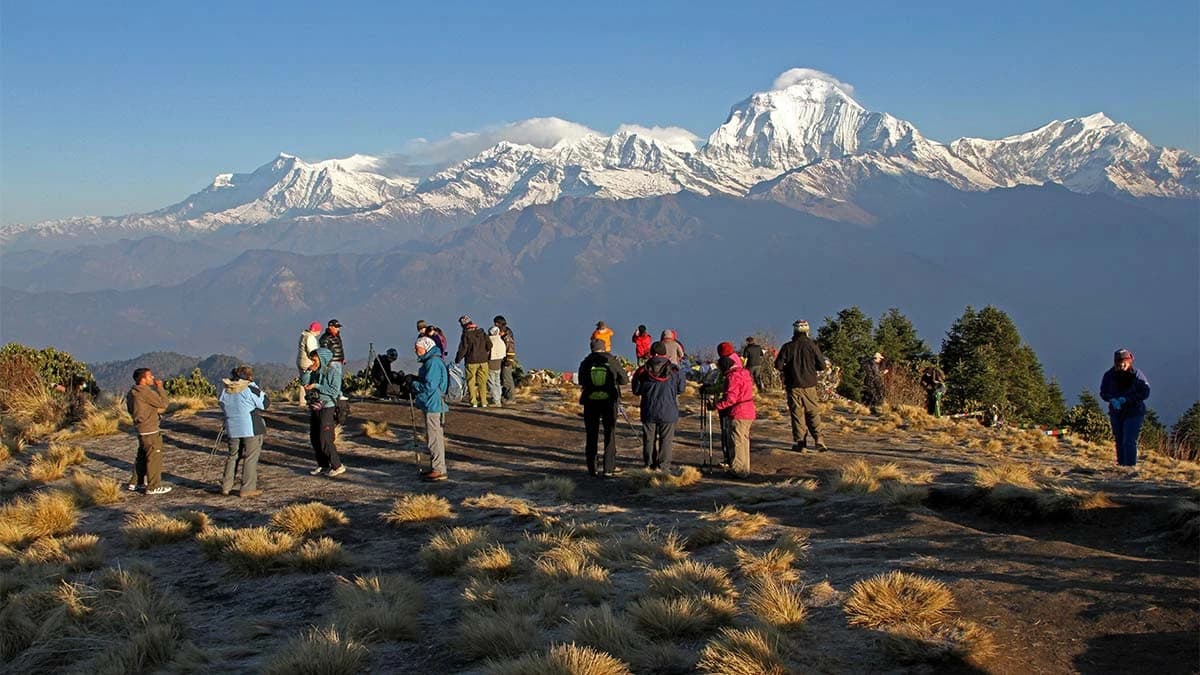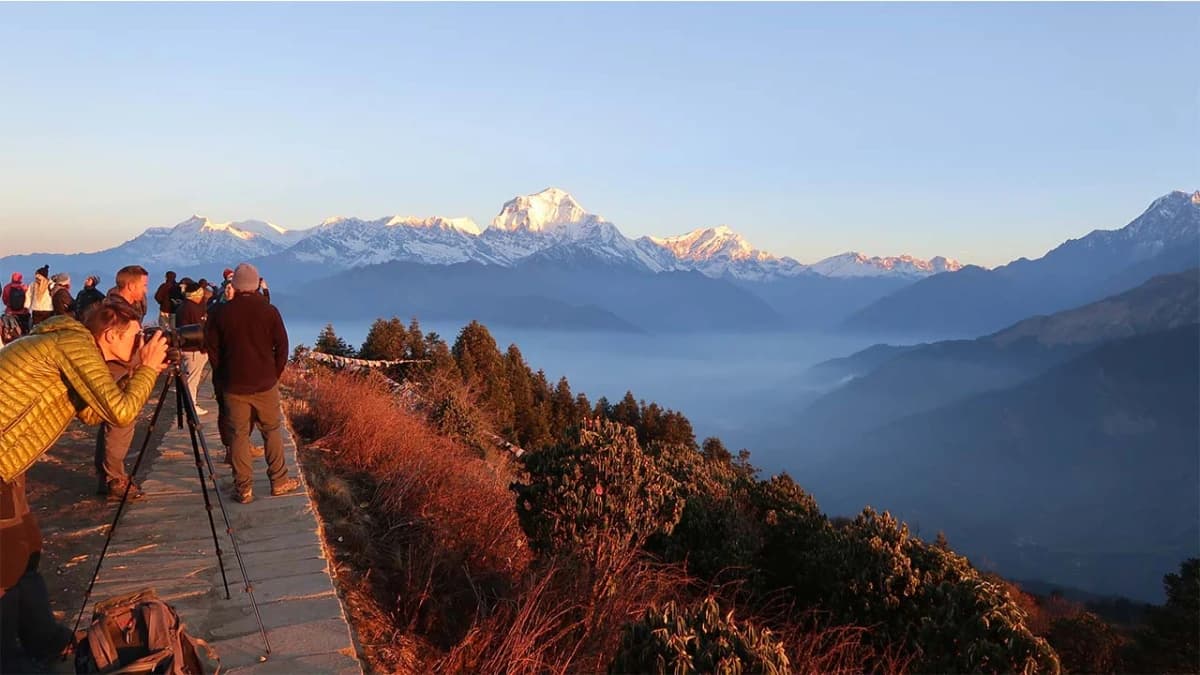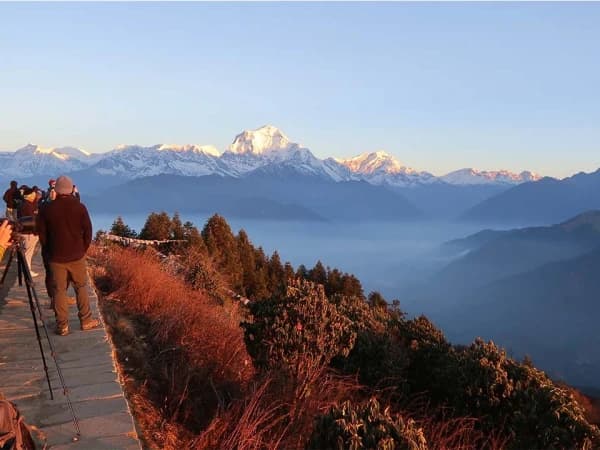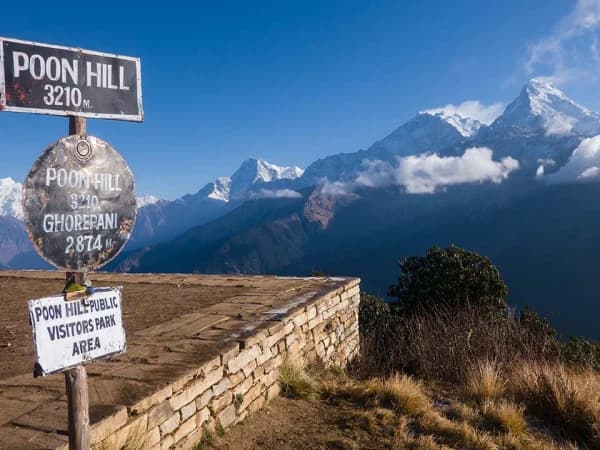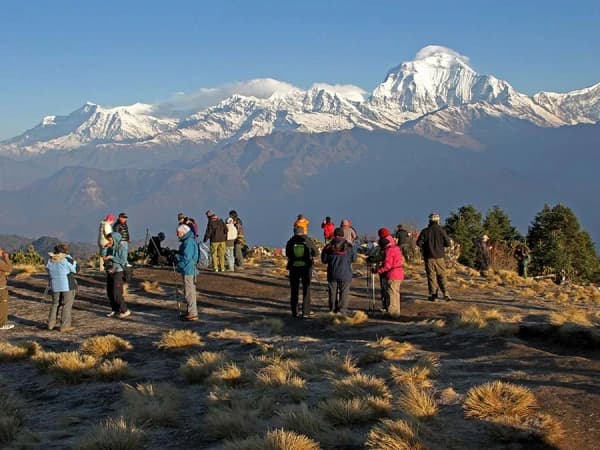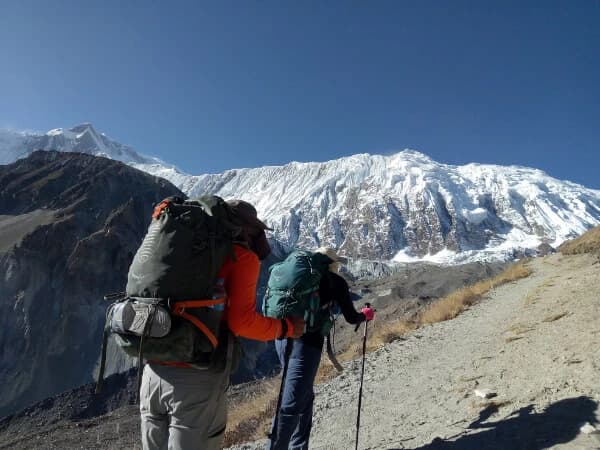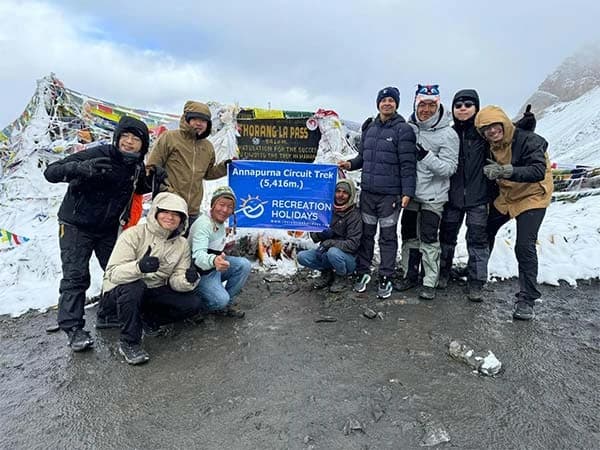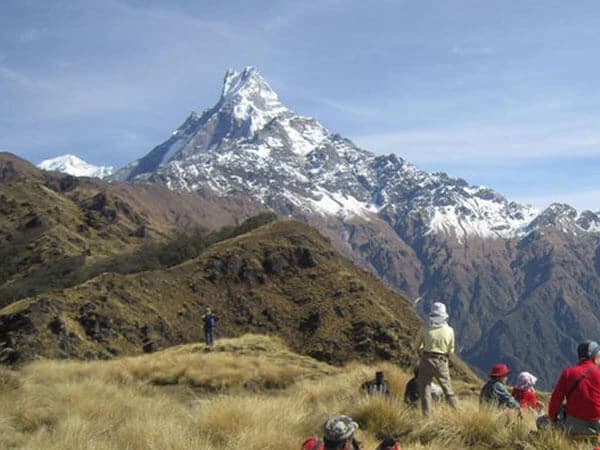Experience the Poon Hill Trek, a perfect blend of adventure and natural beauty. This journey takes you through lush rhododendron forests, traditional Gurung and Magar villages, and scenic mountain trails, while enjoying cozy teahouses, local hospitality, and breathtaking sunrise views over the Annapurna and Dhaulagiri ranges.
Poon Hill Trek
Highlights of the Trek
- Short and immersive trekking adventure through the Annapurna region that offers easy access and stunning Himalayan landscapes
- Magical sunrise views from Poon Hill (3,210 m) over the Annapurna and Dhaulagiri mountain ranges
- Scenic trails that wind through lush rhododendron, oak and bamboo forests, are covered with diverse blooms during spring
- Exploring the traditional Gurung and Magar villages, where you can experience authentic mountain culture, local lifestyle and warm hospitality
- Teahouse supported trekking journey with cozy resting spots, traditional meals and first-hand experience on local Himalayan way of life
- A relatively easy to moderate level trekking journey that is ideal for beginners, families and time-constrained travelers
- Breathtaking vistas of Annapurna South, Dhaulagiri, Machhapuchhre, Hiunchuli, Nilgiri, Tukuche and Annapurna I
The Poon Hill Trek 5 Days is one of the most beloved short trekking adventures in Nepal. This journey combines the Himalayan scenery, cultural charm and accessible trails to offer you a rewarding experience. Your adventure will start from Pokhara, the trails will lead you through terraced farmlands, lush rhododendron forests and traditional Gurung and Magar villages that reflect the warm hospitality of the Annapurna region. Each day in this short trek offers a balance of moderate walking and ample time to enjoy the surroundings. That’s why the Poon Hill Trek Ghorepani is considered an excellent choice for both beginners and experienced trekkers looking for a shorter adventure.
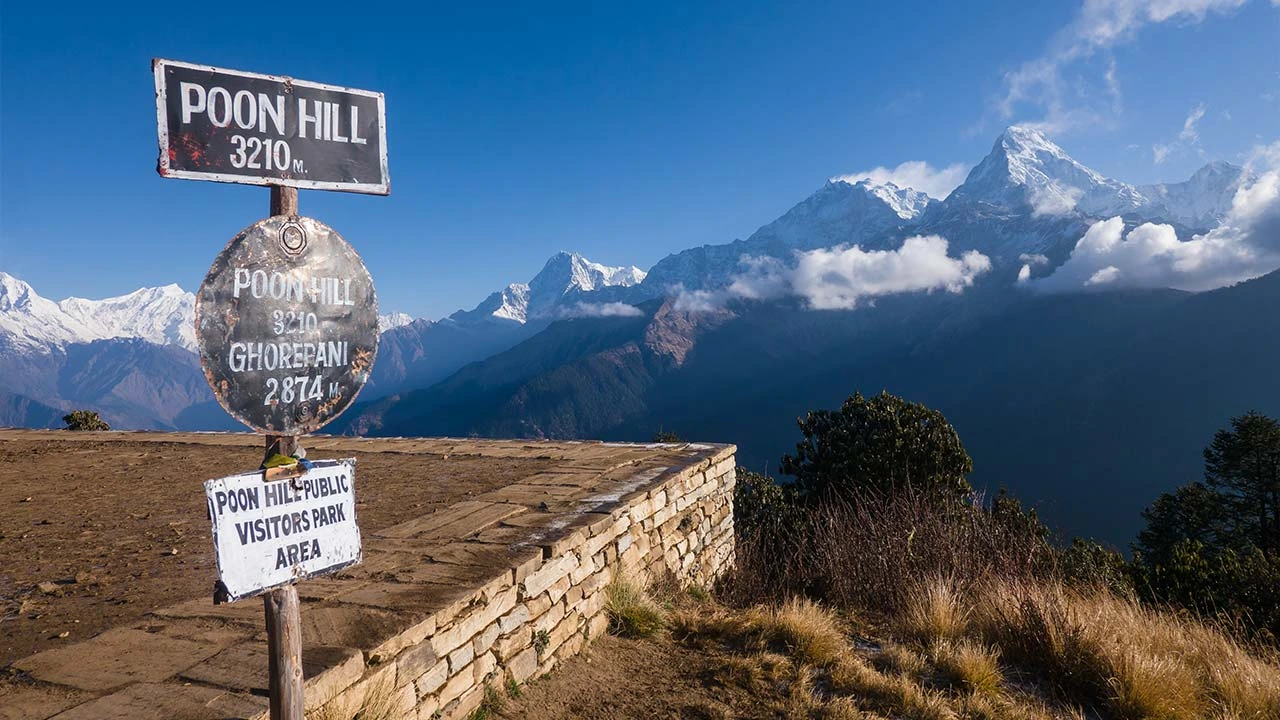
The highlight of this trek is the sunrise hike to Poon Hill (3,210 m). From this famous viewpoint, you will be able to witness the first rays of the sun spilling over the snowcapped peaks of Annapurna, Dhaulagiri, Machhapuchhre, Hiunchuli and other surrounding peaks, creating a breathtaking panorama. This moment is often described as one of the best Himalayan sunrise experiences in Nepal. Beyond the mountain views, the trek offers a cultural encounter with the diverse communities of the lower Annapurna region.
Villages like Ghorepani, Ulleri and Chuile allow you to experience traditional lifestyles of the mountain communities, taste local food and stay in cozy teahouses that make the journey both comfortable and memorable. This Poon Hill Trekking, which has been designed as a 5-day itinerary is perfect for those who want a rewarding Himalayan experience but don’t have weeks to spare. There are no extreme altitude concerns in this trek and the trails are well-maintained, making it ideal for families, solo travelers and even first-time trekkers. As this Poon Hill Trek Pokhara is a good balance of adventure, culture and scenery, it remains one of the best short treks Nepal has to offer.
Short Itinerary Plan
Day 01: Drive from Pokhara (822 m) to Nayapul (1,070 m) and trek to Ulleri (2,050 m): 1.5 to 2 hours (drive) and 3 to 4 hours (trek)
Day 02: Trekking from Ulleri to Ghorepani (2,874 m): 4 to 5 hours
Day 03: Morning hike to Poon Hill (3,210 m) and trek to Chuile (2,195 m): 6 to 7 hours
Day 04: Trek from Chuile to Jhinu Danda (1,780 m): 5 to 6 hours
Day 05: Jhinu Danda to Nayapul trekking and drive back to Pokhara (822 m): 5 to 6 hours (trek) and 1.5 to 2 hours (drive)
Poon Hill Trek Itinerary
Your journey begins with a short but scenic drive from Pokhara to Nayapul. The driving route snakes through terraced hillsides and riverside settlements until you reach the starting point of the trek, Nayapul. From here, the trail leads you along the banks of the Modi Khola and you will pass through Birethanti. This is the first permit checkpoint in your Poon Hill Trek Ghorepani and where the real mountain atmosphere begins.
The walk on thai day’s trail is gentle at first, you will cross suspension bridges and small hamlets like Sudame and Hile. Along the trekking trail you will see the local villagers busy working in fields and the farm animals grazing on hilly pastures. You will then finally arrive at Tikhedhunga Village. The final part of the trail ahead from here is a little demanding as you will have to traverse across stone steps on the steep stretch.
You will walk on over 3,300 stone steps through lush forest and occasional resting points to reach Ulleri. This charming Gurung village is your first rest stop on the Poon Hill Trek 5 Days itinerary. You can enjoy the wide views of the surrounding hills as you settle in for the night.
Leaving Ulleri Village behind, you will move along the trail that gradually eases into a more pleasant walk. First, you will pass Banthanti, a small settlement with some teahouses. From here, the route winds deeper into lush rhododendron and oak forests. The birdlife here is rich, and during spring the entire forest blooms with rhododendron blossoms of red, white and pink.
The Poon Hill Trekking route continues with short climbs and flat stretches until you reach the next village, Nangethanti. This is a common stop for lunch where you can enjoy your food, relishing the scenic surroundings. The forest on this day’s trail feels quiet and cool; the filtered sunlight cuts through the dense forest occasionally. After passing Nangethanti, during the last segment, you will walk a steady ascent that brings you out of the forest and into your destination, Ghorepani.
This Gurung Village is beautifully perched on a higher ridge. The atmosphere here feels lively as the village is filled with trekkers preparing for the Poon Hill sunrise. From here, you start to feel the real presence of the Himalayas. The peaks like Annapurna South, Hiunchuli, and glimpses of Dhaulagiri appear crystal clear above the rooftops. You can spend your evening here resting and preparing for an early start.
This is the major highlight of your Poon Hill Trek 5 Days itinerary. Your hike in the morning begins before sunrise, it takes around 45 minutes to 1 hour to hike Poon Hill from Ghorepani. Once you reach the top at 3,210 meters, the view opens wide, the golden rays of the sun glittering on the pristine snow of Annapurna, Dhaulagiri, Machhapuchhre and Hiunchuli will be a sight to behold. This is the moment you have come for, to completely relish the beauty of one of the most famous sunrise spots in Nepal.
After experiencing the surreal moment and taking photographs, you will then descend back to Ghorepani for breakfast. Then, you will move along with the next part of this day’s adventure. Leaving Ghorepani, you will follow the trail that leads uphill again through Deurali Pass. Then, you will enter the forested paths and pass through rhododendron groves. Along the scenic trail, you will also cross beautiful settlements of Banthanti and Tadapani.
From Tadapani, the trail branches toward Chuile, gradually dropping down through forested slopes and across rushing streams. This stretch feels quieter compared to the busy trekking hub of Ghorepani. As you arrive at Chuile, you will be able to soak in the tranquil atmosphere surrounded by hills. You will settle here for the night after a long but rewarding day.
Before you return back to Pokhara, on this day of your Poon Hill Trek 5 Days itinerary, you will take a side detour to Jhinu Danda. After breakfast in Chuile, you will follow the trail that gently descends through forests of oak and rhododendron. Soon you will arrive at Gurjung Village, a small village tucked along the hillside. From here, the trail begins to level out and you will enjoy a pleasant walk with gradual ups and downs until you approach Chhomrong.
This is one of the larger Gurung villages in the region, which features stone-paved trails with traditional houses, teahouses and wide terraces that overlook the valley. This is also the gateway to the Annapurna Base Camp route. After a short rest here, you will continue walking on the path that turns steep again and drops down countless stone steps toward Jhinu Danda.
The descent is steady but demanding; the Modi Khola river roars louder below as you head toward Jhinu. This village is famous for its natural hot springs, you will have to walk around 15–20 minutes down from the village to reach the natural hot spring beside the river. After days of trekking, soaking in the warm waters with the sound of the river rushing past will be a blissful experience and a remarkable way to pull the curtain on this day’s adventure.
The final day of your Poon Hill Trekking Pokhara starts with a descent from Jhinu Danda, following the trail beside the Modi Khola. The path winds through terraced fields, small farms and scattered villages, sticking close to the river most of the way. You will also pass beautiful villages like Kyumi and Syauli Bazaar along the way. You can pause for a while at these popular stops to enjoy tea or lunch.
The trail at this stretch feels gentler, warmer and dotted with local life. After you cross Syauli Bazaar, the path gradually widens into a dirt road and you will finally arrive at Nayapul, where your trek officially comes to an end. You will board a comfortable vehicle from here and then drive back to Pokhara. The driving route retraces the valley roads and as you enter the serene lakeside, the Trekking Pokhara Poon Hill feels like it was wrapped up in a full circle.
After you reach Pokhara, you can rest for a bit in your hotel and set out on an evening stroll around the lakeside. The epic sunrise view over the shimmering water surface is one of Pokhara city’s charms.
Trip Service Details
Includes
- Ground transportation from Pokhara to the trekking starting point and back to Pokhara after the trek.
- All meals on board (Breakfast, Lunch, and Dinner).
- 4 nights of accommodation on a twin-sharing basis at the teahouses during the trek.
- ACAP (Annapurna Conservation Area Project) permits and TIMS card.
- Local and Government taxes.
- Trained, experienced, Government-certified trekking staff, including guides and other supporting staff.
- Salary, food, accommodation, insurance, and basic equipment for all trekking staff.
- Achievement certificate upon request.
Excludes
- Nepal Visa entry fee.
- Food and accommodation in Pokhara.
- Personal trekking gear, accessories, and equipment.
- Personal expenses such as mineral water, snacks, bar bills, beverages, internet, phone bills, laundry, etc.
- Porter service during the trek (USD 120 per porter, 15-20 kg max).
- Expenses from natural disasters, mishaps, or unforeseen events (e.g., weather or airline issues) are non-refundable and non-transferable, including if you voluntarily choose to leave the trek early or due to any medical emergencies.
- Tips and gratuities for all trekking staff.
- Any costs not mentioned in the “Cost Includes” section.
Additional Info
Best Time to Do
The beauty of Trekking Pokhara Poon Hill is that it can be done almost year-round. But, certain seasons bring out the best of what this route has to offer. Since the main highlight of this trek is the panoramic sunrise view from Poon Hill, weather and visibility play a huge role in shaping your experience.
Spring (March to May) is one of the most rewarding times to do this trek. The skies are generally clear and will reward you with unobstructed views of Annapurna, Dhaulagiri and Machhapuchhre. The forests along the trail also burst into color, especially the rhododendron blooms around Banthanti, Nangethanti and on the way to Ghorepani. Walking under those red and pink blossoms with snow peaks in the backdrop feels surreal. Daytime temperatures in the spring season are mild. Although the mornings can be crisp, the overall trekking conditions are comfortable.
Autumn (September to November) is another prime season for Poon Hill Trek 5 Days itinerary. This season comes after the monsoon, so the air feels fresh. The hillsides are green and visibility is sharp. The weather is stable and the skies remain clear most mornings. So the conditions will be ideal for the sunrise views from Poon Hill. During autumn, the trails are also lively since it’s the most popular trekking season in Nepal.
Off-Season Prospects
You can also do the Poon Hill Trek Ghorepani in the off-season, but the conditions are not ideal as the peak seasons. Winter (December to February) brings a quieter atmosphere. The trails are less crowded and visibility remains excellent on clear days. The air is crisp and the mountains look breathtaking with fresh snow. But at the higher regions, especially around Ghorepani and Poon Hill, it can get cold with snowfall at times. If you are prepared for colder temperatures, this can be a peaceful time to enjoy the trek, bypassing the huge flow of travelers in peak seasons.
On the contrary, monsoon (June to August) is the least favorable season for this trek. During this rainy season, the trails get muddy and slippery. Also, leeches are common in the lower, forested sections. Rain often clouds the views, especially in the mornings, which make the Poon Hill sunrise less predictable. On the brighter side, the villages and forests are lush and full of life due to nourishment. And, if you don’t mind the rain, the monsoon trek offers a more local and offbeat experience in a tranquil setting.
What is the Difficulty Level of Ghorepani Poon Hill Trek?
The Poon Hill Trekking Route is often considered as one of the easier treks in the Annapurna region. However, it doesn’t mean this trek is just a casual stroll. This exciting adventure lasts about 4 to 5 days and does not take you to extreme altitudes like Everest Base Camp or Annapurna Base Camp. The highest point is Poon Hill at 3,210 meters, so the altitude-related risks are very minimal. However, along the trekking route, you will have to deal with sections that demand effort, especially for those new to trekking in Nepal.
Although not strenuous, the uphill stretches will test your stamina and leg strength. Beyond the 3,300 steps past Ulleri, the trail gets more forgiving, with gradual ascents and descents through forests and villages. The daily walking hours in the Poon Hill Trek Ghorepani range between 4 to 5 hours, depending on the section. The paths are well-defined and maintained, which makes the trek manageable even for beginners, families or older trekkers who pace themselves. Weather can add another layer of difficulty if you are planning your trek fro the off-season. In winter, icy patches and snow around Ghorepani can make walking more demanding. Whereas, during the monsoon, muddy trails and leeches in the lower forests can slow you down.
But during the peak seasons like spring and autumn, the conditions are generally straightforward and friendly for all levels. In terms of physical aspects, you don’t need to be a seasoned trekker or an athlete to complete the Poon Hill Trek. Just a basic level of fitness, being able to walk for several hours uphill and downhill for consecutive days, will be sufficient.
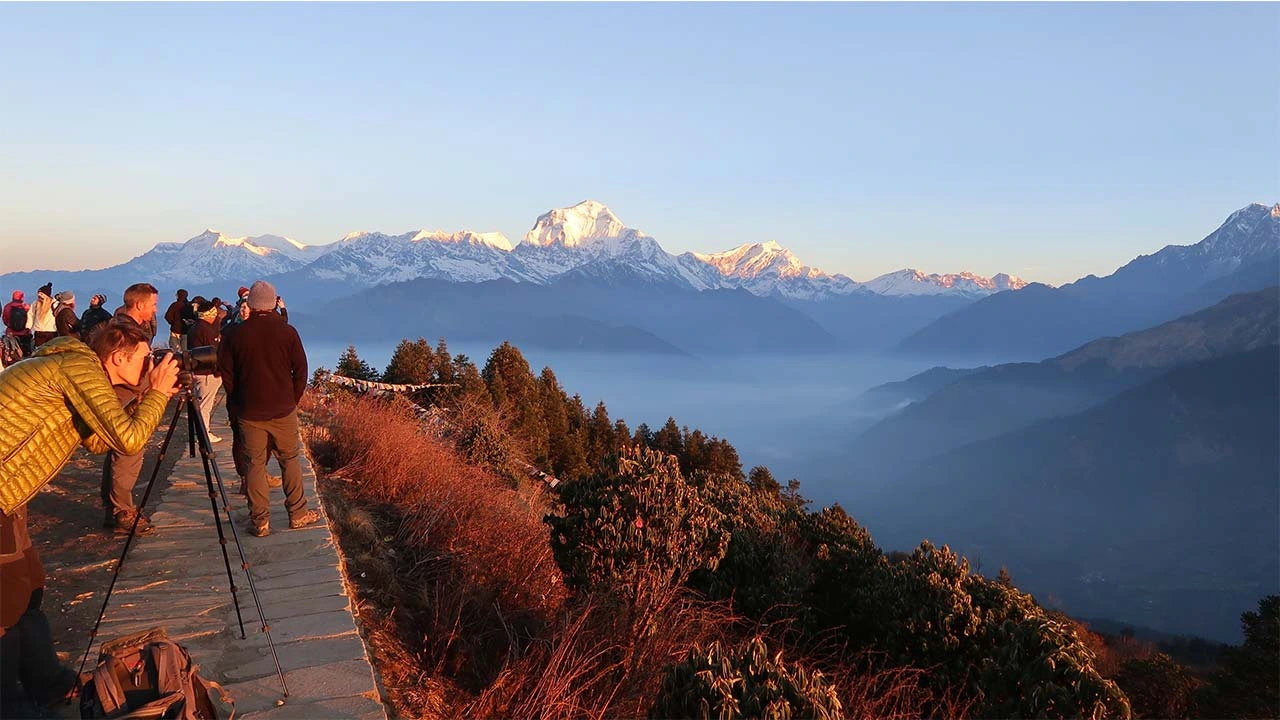
Total Trek Distance
The Poon Hill Trek covers a total distance of roughly 40 to 45 kilometers (25 to 28 miles). Due to its short distance, Poon Hill Trekking is considered one of the most accessible treks in the Annapurna region. You will cover this trekking distance over 4 to 5 days of walking. The trekking distance is balanced in a way that you cover enough ground each day to feel like you are on a real mountain journey, but never to the point where it feels overwhelming. During this trek, you will walk around 4 to 6 hours per day on average, the overall distance coverage will depend on your pace and breaks.
Compared to other longer Himalayan treks like Annapurna Circuit or Everest Base Camp, the overall distance of Poon Hill is modest. That’s why this trek is often described as a beginner-friendly adventure. What makes the trek interesting is not just the distance but also how the trail stretches across the landscape. The first big challenge in this trek is the famous stone staircase climb to Ulleri. Beyond that point, the trail passes across the forested paths, ridgelines and lush hills. The highlight of this trek is the side trip up to Poon Hill for the sunrise view. This section is not a long walk in terms of distance, but it is a little bit intense due to its steep climb at early hours.
Accommodation and Food on the Trek
The Poon Hill Trek is one of the most popular short routes in the Annapurna region. So, you will find accommodation and food options well established along the trail. This trek is fully based on teahouse lodging. This means every village you pass through has family-run guesthouses that provide simple rooms and home-cooked meals. The rooms in the teahouses are basic but cozy, usually with wooden walls, twin beds, mattresses, pillows and blankets.
In busier places like Ghorepani and Chhomrong, some lodges even offer slightly better facilities, such as attached bathrooms or hot showers for an extra charge. At the lower part of the trail, electricity and Wi-Fi are available, though you may need to pay an extra cost to use the services. Teahouses also generally have a heater or fireplace in the dining hall where trekjkers can gather around for warmth and share stories. Although luxury services are not available at every stop, the comfort provided by the teahouses is more than enough to make the trek pleasant.
Food Options
The menus during the Poon Hill Trek Pokhara are surprisingly diverse, with every teahouse following a similar kind of pattern. The classic staple meal at the teahouses is Dal Bhat (rice, lentil soup, vegetables, and pickles) which is unlimited in servings and keeps trekkers fueled for long walking days. Other popular menus at the teahouses include fried rice, noodles, momo dumplings, pasta, soups, pancakes, omelets, etc. In villages like Ghorepani and Tadapani, there are also bakeries that offer fresh bread and cakes.
As for the breakfast option, they are simple but filling. You can start your morning adventure with porridge, Tibetan bread with jam, boiled eggs, or tea and coffee. Drinks range from herbal teas to ginger lemon honey, cold drinks, seasonal fruit juice and even local alcoholic beverages. Bottled water is available, but due to high cost, most trekker refill their bottles with boiled or filtered water at the teahouses.
Packing List – What to Bring?
Even though the Poon Hill Hike Nepal is a short and beginner-friendly adventure, the trail still passes through the heart of the Annapurna foothills. In these parts of the Himalayas, the weather can shift quickly, the routes are demanding and you will traverse different climatic zones. So, having the right gear makes the difference between a trek that feels like a struggle and one that feels comfortable and enjoyable.
This Poon Hill Trek packing list is not about overpacking, but it is about carrying just what you need so that every day on the trail will flow smoothly. Here is our carefully curated packing list to help you make your Poon Hill adventure a sweet and unforgettable memory.
Clothing
- Base layers (thermal tops and bottoms)
- Trekking shirts and t-shirts
- Long-sleeve trekking shirt
- Light fleece or sweater
- Down jacket
- Windproof jacket
- Rain jacket or poncho
- Trekking pants
- Lightweight casual pants
- Hiking shorts
- Innerwear/undergarments
- Neck gaiter or buff
- Sun hat or cap
- Gloves (lightweight pair and warm wool or insulated pair)
- Socks (mix of light and warm pairs)
Footwear
- Trekking boots
- Sports or trainer shoes
- Camp slippers or crocs (to relax in the evenings)
- Trekking socks (thin and woolen or insulated pairs)
- Sock liners

Gear and Accessories
- Backpack (30 to 40 L, for daily essentials)
- Duffel bag
- Water bottle or hydration bladder
- Water purification system or tablets
- Trekking poles
- Sunglasses with UV protection
- Headlamp or flashlight (with extra batteries)
- Power bank
- Universal adapter
- Trekking map, guidebook, or GPS system
Personal Essentials
- Toothbrush and toothpaste
- Biodegradable soap and shampoo
- Light travel towel
- Sunscreen cream and lip balm (with UV protection)
- Perfume and foot powder
- Hand sanitizer
- Toilet paper, tissue paper, and wet wipes
- Insect repellent
- Small first aid kit
- Personal medications
- Snacks and energy bars
- Reusable shopping bag
- Travel documents
- Cash in Nepali Rupees
Permit Requirement
Before embarking on the adventure of Poon Hill Trekking Pokhara, it is important to understand the permit requirements along the route. This is a protected area and trekking without the proper permits is not allowed here. For this short and exciting trek, just a single permit is required. So, the overall process is simple and affordable. You can obtain the necessary permits in Pokhara or Kathmandu.
Permits for Poon Hill Trek
- Annapurna Conservation Area Permit (ACAP)
The only required permit for this trek is the Annapurna Conservation Area Permit (ACAP). This permit is issued to all trekkers entering the Annapurna region. To apply for the conservation area permit, you will need to submit a valid passport, passport-sized photographs and a copy of your trekking itinerary. If you plan your trek through a reputable trekking agency like Recreation Holidays, they will handle all the permit arrangements for you. This way, you can focus on your adventure rather than paperwork.
Training and Preparation
Even though the Poon Hill Trek 5 Days itinerary is considered beginner-friendly and short compared to other Himalayan treks, proper preparation is crucial. You need to prepare adequately to make the journey smooth, enjoyable and safe. The trekking trails involve multiple hours of daily walking, steep staircases, gradual elevation gain up to 3,210 meters at Poon Hill and long descending stretches. So these aspects of the walking route can put strain on your muscles and joints if you are not prepared. Along with the physical demands, mental readiness is equally important. For trekking in the mountains, patience, resilience, and the ability to adapt to changing conditions are quite essential.
So in order to handle these challenges comfortably, it is important for you to build cardiovascular endurance, leg and core strength, and flexibility before the trek. Regular cardio workouts like running, power walking, cycling, or stair climbing improve your overall stamina and endurance level. You also need to prioritize your leg strength training as it will be tested the most during the trek. Similarly, if you do practise hikes near steep hills, it will help you with terrain familiarity and acclimatization practice.
Mental Preparation
Trekking in the Himalayas is not just about physical fitness; your mind plays a big role in how the overall experience will turn out to be. Preparing mentally helps you stay calm, focused, and positive throughout the journey. Here are key elements that you can focus on for mental preparation:
- Be patient and manage your pace
- Be flexible and ready to adapt
- Have a positive mindset
- Motivate yourself with goal setting
- If you find the trekking route challenging, break your goals into smaller portion
- Surround yourself with positive people
- Visualize the journey, not just the route, butalso accommodation, food and available services
Group Joining and Private Trek
When planning the Poon Hill Trek Pokhara, you have the option to choose between a group trek or a private trek, depending on your preferences and style of travel. A group trek is usually organized by trekking agencies. This setup brings together multiple trekkers from all around the world following the same itinerary. The group is led by a guide who navigates the trail, manages permits and ensures that teahouse arrangements run smoothly. Joining a group is ideal for those trekkers who enjoy companionship on the trail, want the support of a guide and prefer a well-structured trekking schedule. Walking with others also gives you opportunities to socialize and share experiences, which makes your experience more lively and interactive.
As for the private trek, this option is personally tailored for you and your travel companions. In the private trekking option, you will have a private guide and you can hire as many porters as you want. You will also have full control over the itinerary plan, from walking face, resting stop, to side excursion. This trekking option will offer you a more personalized experience. So, you will be able to focus on the scenery, photography, or simply soaking in the mountain atmosphere. All of this without following a fixed schedule.
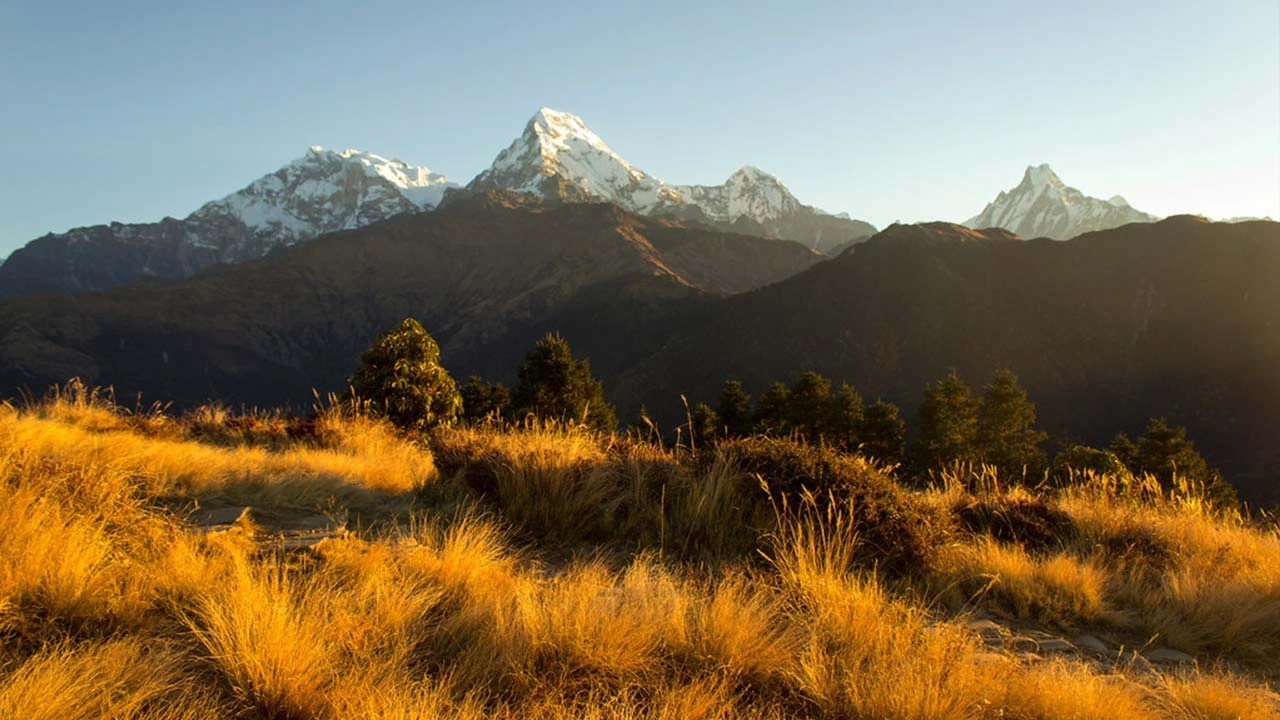
Trek Cost
The Poon Hill Trek 5 Days cost is one of the most affordable trekking adventures in Nepal. That’s why it is an excellent choice for those who want a Himalayan experience without the expense and time commitment of longer treks. On average, a standard Ghorepani Poon Hill Trek price is around US$ 450 to US$ 550 per person. The price range will depend on the overall itinerary plan, level of services, side excursion, season of visit, number of trekkers, etc. The Poon Hill Trek package at this price range generally covers all the main expenses of the trek, such as accommodation, meals, transportation, trekking permits and a guide.
But, to stay on the safer side, it's best if you book the package only after checking the includes and excludes segment. For a hassle-free experience, booking through a trusted trekking company is often the best choice. At Recreation Holidays, we are offering Poon Hill Trek 5 Days package at just US$ 480 per person. We offer excellent value considering what’s included. With this package, you will get experienced local guides, smooth transport, proper permit management and well-organized teahouse accommodations.
Customization Option
One of the advantages of trekking to Poon Hill with Recreation Holidays is the flexibility we offer when it comes to customizing your journey. Even though the standard itinerary is 4 to 5 days, you can easily adjust the schedule, pace, or route as per your preferences, fitness level and interests. For example, you can extend the trek to include nearby villages like Ghandruk or Tadapani for extra cultural and scenic experiences, or add a rest day to fully enjoy the sunrise from Poon Hill without rushing.
Likewise, you can also combine the trek with a short Pokhara sightseeing tour before or after, making the trip more rounded and personalized. In the customization option, you will also have full control over how long you walk each day, where to stop and what side routes to explore. Ouer expert and veteran team will design the itinerary according to your preferences, ensuring that your experience is tailored entirely to you.
Altitude Sickness
Although the Poon Hill Trek is a short and beginner-friendly trek taht doesn’t push to major elevation points, altitude sickness is still something you should be aware of. The trek reaches its highest point at Poon Hill (3,210 meters). While this elevation is moderate compared to higher Himalayan treks, some trekkers may still experience mild symptoms of Acute Mountain Sickness (AMS) if a proper acclimatization schedule is not followed. The common symptoms of altitude sickness include: headache, nausea or loss of appetite, dizziness or lightheadedness, shortness of breath and trouble sleeping.
To avoid risks of altitude sickness, you need to ascend gradually, eat a balanced diet, hydrate regularly, rest where necessary and maintain a steady pace. You can also take the altitude sickness medication, but it is necessary to consult your doctor for that. Being aware and prepared ensures that your Poon Hill Trek remains a safe, enjoyable and memorable Himalayan experience without any serious altitude issues.
Travel Insurance, Health and Emergency Rescue
Even though the Poon Hill Trek is a short and low-altitude adventure, being prepared with travel insurance, staying healthy and knowing emergency options is essential. The Himalayas can be unpredictable at times, the trails may be slippery, weather can change quickly and minor injuries or illness may occur.
That’s why all trekkers should have comprehensive travel insurance that covers trekking in the Himalayas, including helicopter evacuation if needed. Maintaining health through proper hydration, balanced meals, rest and hygiene helps prevent fatigue and illness. You can also check the vaccination details if you are not upto date with the necessary vaccines
If there is any kind of emergency during the trek, helicopter evacuation, assistance from experienced guides and porters and local health posts in villages such as Ghorepani and Chhomrong will provide the necessary support. By combining insurance, health awareness, and knowledge of rescue services, you can enjoy the Poon Hill journey safely and comfortably. If you are doing this trek through an agency, they will handle the safety details and coordinate with your insurance company for emergency evacuation (if needed).
Internet, Connectivity and Charging on the Trail
Poon Hill Trek Ghorepani takes you deep into the Annapurna region, but staying connected is still possible, though it is limited compared to city areas. Mobile networks like Ncell and Nepal Telecom provide coverage in most major villages along the trail, including Nayapul, Tikhedhunga, Ghorepani and Tadapani. However, the signal can be weak and unreliable in forested areas or steep valleys at the higher stretches.
Internet access is usually available through Wi-Fi in teahouses, though it may be slow and you will need to pay a small fee to use the service. You can also charge your devices at the teahouses and like the internet, you will need to pay an extra fee to use this facility. Carrying a power bank is highly recommended to keep phones, cameras, or your other electronic devices functional throughout the trek.
By planning ahead and managing expectations, you can stay in touch when needed while still enjoying the disconnecting to immerse in the Himalayas. The limited connectivity actually enhances the trekking experience as it allows you to focus on the trail, the views and the living culture.
Porter and Guide
For the Poon Hill Trek Pokhara 5 Days, hiring a guide and porter is not mandatory. But it can greatly enhance your experience, especially so if you are a first-time trekker or just someones who want to enjoy a hassle-free experience. A guide is invaluable on this journey, even though the trails are well-marked. Guides will provide you with local knowledge about the villages, culture, flora, and fauna, help with permits and ensure the group or individual stays on the correct path. Guides are also trained to monitor trekkers for signs of fatigue or mild altitude sickness and they will take care of your overall health. This will provide reassurance and safety throughout the trek.
As for the porters, they will carry your luggage and you will be able to walk lightly with just a daypack. This makes the climbs, especially the steep sections like Ulleri much easier and more enjoyable. Porters are experienced in navigating the trail, managing loads efficiently and assisting in case of minor injuries or unexpected difficulties. You will also gain valuable local insights as porters are mostly natives from around the region. So, in overall, hiring a guide and porter not only reduces physical strain but also provides peace of mind, letting you focus fully on the views, the villages and the serene Himalayan environment.

Travel Visa
The Nepali Tourist Visa is essential for all foreign nationals except Indian citizens to enter Nepal. The process of applying for and obtaining the Nepal tourist visa is simple and can be done on arrival at Tribhuvan International Airport in Kathmandu. There are also several land border entry points where you can apply for this visa. Upon arrival at the TIA, you just need to fill out a short form, provide a couple of passport-sized photographs and pay the visa fee. The visa is then issued within a few minutes, allowing you to start your journey without delay.
There are three types of tourist visas available:
- 15 Days Visa— US$ 30
- 30 Days Visa— US$ 50
- 90 Days Visa— US$ 125
To apply for the visa, your passport must have a validity of at least six months from the date of arrival in Nepal. For the Poon Hill Trek 5 Days Itinerary, most trekkers opt for the 15-day visa, which is more than sufficient for this short adventure. However, if you plan to combine the trek with other activities in Nepal, such as visiting Pokhara, Chitwan, or Lumbini, the 30-day visa offers more flexibility and is a convenient option.
Poon Hill Trek FAQs
The Poon Hill Trek usually takes 4 to 5 days, starting and ending in Pokhara. The overall duration will depend on your pace, chosen route and how much time you want to spend in villages along the way.
A guide is not mandatory for Poon Hill since the trails are well-marked and easy to follow. However, hiring a guide will add value to your experience through local insights, easier navigation, cultural interpretation and from safety aspects as well. If you are new to trekking in Nepal, a guide can make the experience smoother and more enriching.
The Poon Hill Trek 5 Days itinerary is considered an easy to moderate level adventure. The trails involve lots of stone steps and steady climbs, but there are no technical sections or high-altitude risks. Anyone with average fitness can do it, including families, beginners and even senior trekkers.
A licensed trekking guide typically costs US$ 30 to 35 per day, this price range generally includes their daily fee, food and accommodation. If you hire a guide through an agency, the cost may be slightly higher but comes with better reliability and organization.
Yes, it is possible to complete this trek in 2 days, but it will feel rushed. A 2-day trek usually means driving to Nayapul or Ulleri on day one, trekking to Ghorepani, and then doing the sunrise hike to Poon Hill the next morning before returning.
No, Mount Everest is not visible from Poon Hill. The viewpoint offers stunning panoramas of the Annapurna and Dhaulagiri ranges, but Everest lies further east, so it cannot be seen from this viewpoint.
In the present situation, there is no direct road to Poon Hill. The only way to reach the viewpoint is by trekking from Ghorepani village, which takes about 45 minutes to an hour on foot. Jeeps can take you up to certain villages like Ulleri or Hile to shorten the trek.
Poon Hill is world-renowned for its sunrise view over the Himalayas, especially Annapurna and Dhaulagiri massifs. The sweeping panorama of snow-covered peaks glowing golden at dawn is considered one of the best mountain views in Nepal, which is accessible through a short trek.
A good alternative for the Poon Hill Trek Ghorepani would be the Mardi Himal Trek, which offers equally stunning views of Annapurna South, Machhapuchhre (Fishtail) and Hiunchuli with fewer crowds. Another option is the Khopra Danda Trek, which is a slightly longer route with panoramic Himalayan scenery and more peaceful path.
Yes, the Annapurna range dominates the view from Poon Hill. Peaks like Annapurna I, Annapurna South, Machhapuchhre and Hiunchuli rise across the horizon while you climb to this viewpoint for the sunrise view.
Travelers’ Review
My family planned a one-week vacation and decided to explore Nepal. Based on a friend’s recommendation, we chose the 5-day Poon Hill Trek and booked...
I recently completed the Poon Hill trek with a friend, and it was truly an unforgettable experience! The trail offered stunning and diverse landscapes, from the...
My wife and I chose Recreation Holidays for our Poon Hill Trek to celebrate our first anniversary, and it was an amazing experience. Mr. Hari...

